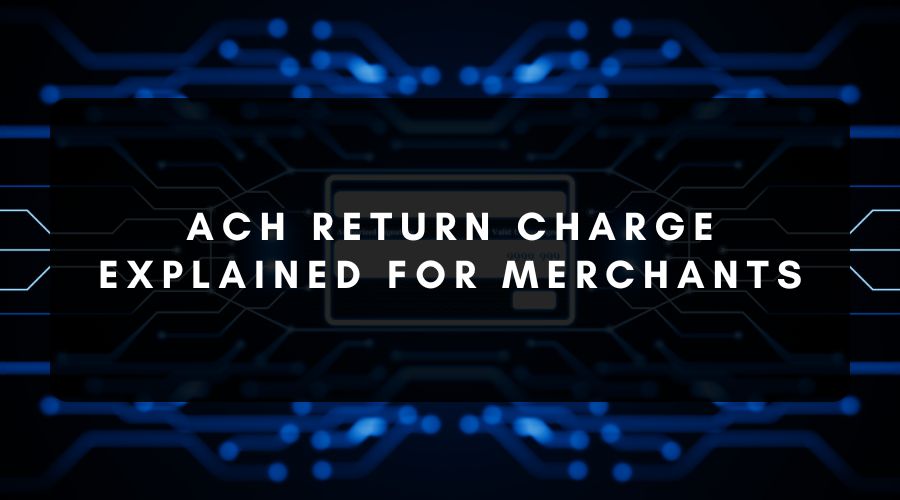
ACH Return Charge Explained for Merchants
Occasional hiccups with the ACH network are inevitable in the fast-paced world of electronic payments. One hurdle you might encounter is the ACH return charge; these bounced ACH transfers can disrupt your cash flow and cause unnecessary headaches.
By understanding the common causes of ACH returns and implementing proactive strategies, you can significantly reduce their occurrence. This will protect your bottom line by avoiding additional charges.
What Are ACH Returns?
Automated Clearing House (ACH) returns happen when an ACH payment fails or is completed and subsequently reversed. ACH payments are a type of electronic transfer mostly used in the United States. European businesses may be more familiar with SEPA payments which are the European version of ACH. ACH failures can occur at the point of sale or when a payment is initially accepted but is later rejected. You could think of it as the electronic version of a bounced check.
Understanding how ACH payments work and how to prevent ACH return charges is necessary for EU-based companies with branches in the States or with U.S.-based customers. ACH payments accounted for an average daily value of 163.7 billion dollars in the first quarter of 2024, so preventing ACH returns and the associated charges is essential for businesses that accept this payment method.
What Are ACH Return Charges?
ACH return charges are fees businesses pay when an ACH return occurs. Charges range between $2 and $5 depending on the ACH processor. Additional fees may also be charged by the user’s bank if the ACH transaction is returned because of insufficient funds or if the transaction leads to the use of the customer’s overdraft.
Who Are the Parties Involved in ACH Returns?
There are two main financial institutions involved in ACH returns:
Originating Depository Financial Institution (ODFI)
An ODFI is a financial institution that delivers ACH debit and credit requests to its ACH operator. In the case of an ACH return, the requested ACH transaction is not completed or is completed and later reversed.
Receiving Depository Financial Institution (RDFI)
The RDFI is the financial institution that receives the ACH debit or credit request. The RDFI alerts the ACH network when there’s a problem with a transaction that means it can’t be completed.
Why Do ACH Return Charges Occur?
ACH returns occur for several reasons. These include having insufficient funds, wrong account information, risk of fraud, administrative errors, or if the customer requests their bank to place a stop payment on the transfer.
When an ACH return occurs, the network provides ACH return codes which help your company understand why the return has happened. These codes are key to recovering the funds your business is owed. The following are examples of the most common ACH return codes:
- R01 Insufficient Funds: This occurs when a customer doesn’t have enough money in their account to cover the transaction.
- R02 Account Closed: Either the ODFI or the RDFI closed the account in question for sending or receiving funds. If you know your account is operational, your customer has probably closed theirs.
- R03 No Account: This doesn’t mean that the account has closed like in the case of an R02; it means the account never existed.
- R04 Invalid Account Number: You’ll receive this code if the client’s bank account number is wrong.
How Do ACH Return Charges Affect Businesses?
The risks of ACH return charges for businesses include financial loss, operational difficulties, and damage to your business’s reputation.
Financial Loss
- “Returned transaction” fees: The most immediate financial impact is the return charge itself. When an ACH transfer bounces, the originating bank typically charges the receiving business a fee to cover the processing costs and potential disruptions caused by the failed transaction.
- Disrupted cash flow: Waiting for a payment can cause cash flow gaps. This can make it difficult to manage your finances.
Operational Challenges
- Increased administrative work: Dealing with returned ACH transactions requires additional administrative work. You’ll need to track down the reason for the return, contact the customer, and attempt to collect payment again. This can divert valuable time and resources away from focusing on core business activities.
Reputational Damage
- Customer dissatisfaction: Customers who experience delays or issues due to bounced payments (due to a mistake on your end) may be less likely to do business with you again and could leave negative reviews, harming your reputation.
How to Prevent ACH Return Charges
There are several things you can do to prevent ACH return charges:
Keep Accurate and Up-to-Date Customer Information
Paying close attention to detail can help prevent ACH returns. Inaccurate or out-of-date customer information can lead to issues down the line. Check bank account numbers, customers’ addresses, routing numbers, and any other relevant information carefully before initiating the transaction.
Set Up Recurring Payments
Setting up recurring payments can prevent ACH returns by removing the possibility of an administrative assistant entering the account details incorrectly for a future payment.
Remind Your Customers of Upcoming Payments
Communicating with your customers before their upcoming scheduled debits can prevent misunderstandings that lead to ACH returns. Warn them when and how much you’ll debit with enough time for them to top up their account or cancel the recurring payment.
Use Fraud Detection Technology
Anti-fraud technology is especially important for merchants looking to prevent ACH returns. When setting up your e-commerce business, look for a payment processor that provides cutting-edge fraud detection technology.
Be Cautious with High-Risk Transactions
Certain types of transactions can result in higher numbers of returned entries. These could be especially large amounts of money or those involving new end users. In these cases, consider using additional safeguards such as an identity verification process.
Can European Merchants Set Up ACH Payments for U.S. Customers?
If your European business has a branch or branches in the U.S., you may want to consider setting up ACH payments. You can use a secure web form or encrypted e-mail service to receive your customers’ bank account information.
ACH payment processing doesn’t work in exactly the same way as with credit card payments, as these payments don’t go through a payment gateway. Rather, your payment processor will initiate recurring ACH payments. You’ll see these sales reflected in the sales reports provided in your merchant services package.
Protect Your Business from ACH Return Fees
If you wish to use ACH payments in your business, you must take steps to optimise the process and avoid costly ACH return fees. Working with a secure payment processor saves your business time and money by reducing administrative hurdles and the costs that result from ACH returns.
Businesses that embrace different payment methods can attract a wider range of customers. Reducing the fees involved in each of these payment methods keeps more of your hard-earned money where it belongs: in your business bank account.

